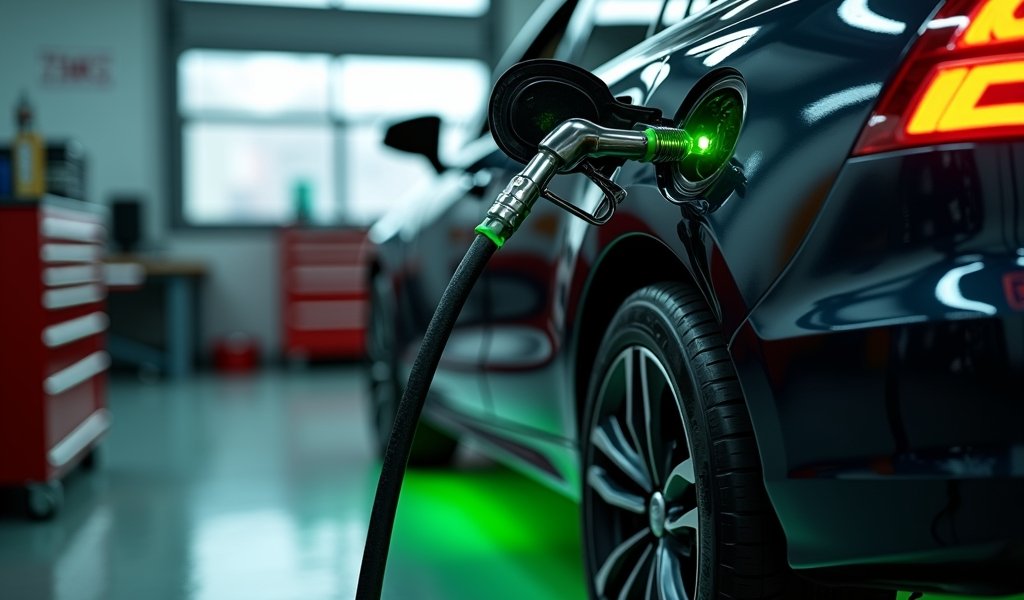Overview
The article provides five key tips for safely using biodiesel in diesel engines: check engine compatibility before switching blends, consider climate and temperature factors, follow proper storage guidelines, monitor fuel system components more frequently, and transition to higher blends gradually. These practical recommendations from a 20-year diesel mechanic help users navigate biodiesel blend ratio limitations while avoiding costly engine damage and maintenance issues.
Table of Contents
- Understanding Biodiesel Blends
- Tip #1: Check Engine Compatibility Before Switching Blends
- Tip #2: Factor in Climate and Temperature
- Tip #3: Follow Proper Storage Guidelines
- Tip #4: Monitor Your Fuel System Components
- Tip #5: Make a Gradual Transition to Higher Blends
- Conclusion
- Frequently Asked Questions
Understanding Biodiesel Blends
Biodiesel blend ratio limitations aren’t just technical jargon—they’re crucial guidelines that can make or break your engine’s performance. As a diesel mechanic with 20+ years in the field, I’ve seen my fair share of fuel-related issues that could have been avoided with proper understanding.
Biodiesel is a renewable alternative to traditional petroleum diesel, derived from vegetable oils, animal fats, or recycled cooking grease. When we talk about biodiesel, we’re referring to blends labeled with a “B” followed by a number indicating the percentage of biodiesel in the mix.
The most common blends you’ll encounter are:
- B5: 5% biodiesel, 95% petroleum diesel
- B20: 20% biodiesel, 80% petroleum diesel
- B50: 50% biodiesel, 50% petroleum diesel
- B100: 100% pure biodiesel
Higher biodiesel percentages aren’t necessarily better for every vehicle. Each blend comes with specific limitations that affect performance, fuel system durability, and maintenance needs. The National Renewable Energy Laboratory’s research shows that while biodiesel offers environmental benefits, using inappropriate blends can lead to fuel system issues.
Finding the right balance is key—you want enough biodiesel to get the environmental benefits without compromising your engine’s performance or longevity. Let’s break down the most important considerations to keep in mind.

Tip #1: Check Engine Compatibility Before Switching Blends
Before you fill up with that higher biodiesel blend, take a moment to check what your engine can actually handle. Your owner’s manual is your best friend here. Most manufacturers clearly state which biodiesel blends are compatible with your specific engine model.
Here’s what I’ve observed across different diesel engines:
- Engines manufactured after 2010 typically accept B5 to B20 without issues
- Older engines (pre-2000) may require modifications for anything above B5
- Commercial heavy-duty engines often have different tolerances than passenger vehicles
Just last month, I had a customer bring in a 2008 Volkswagen TDI with serious fuel system issues. He’d been running B50 in an engine designed for maximum B5 compatibility. The result? Failed injectors and a clogged diesel fuel filter water separator system—a $2,800 repair that could have been avoided by simply checking the manual first.
Beyond the manual, look for fuel compatibility decals near your fuel door or engine. Many manufacturers started adding these around 2007 when biodiesel became more mainstream. If you can’t find specific information for your vehicle, stick with B5—it’s the safest blend for virtually all diesel engines.
Remember: exceeding the manufacturer’s recommended blend ratio is a gamble with your engine’s health and your warranty. That “greener” B20 blend might save a few trees, but it could cost you a forest of repair bills if your engine isn’t designed for it.
Tip #2: Factor in Climate and Temperature
Temperature matters enormously when it comes to biodiesel performance. Unlike petroleum diesel, biodiesel has a higher gel point—the temperature at which it thickens and can clog your fuel system. This property changes dramatically based on the blend ratio you’re using.
In my Minnesota shop, we see this issue every winter. While conventional diesel might start gelling around -10°F, a B20 blend might begin thickening at 20°F. For those in colder climates, this presents a serious challenge.
Here’s a practical temperature guide based on my experience:
- B5: Generally safe in temperatures as low as conventional diesel
- B20: Requires caution below 20°F
- B50: Not recommended below 32°F without additives
- B100: Problematic below 40°F; consider heated fuel tanks
One longtime customer who runs a trucking company switches from B20 in summer to B5 in winter—a simple but effective seasonal strategy. This approach allows him to balance environmental benefits with practical operation.
If you’re committed to higher blends year-round, consider these cold-weather strategies:
- Use cold-flow improver additives specifically formulated for biodiesel
- Install fuel heaters or insulated fuel lines
- Keep vehicles in heated garages when possible
- Mix in some #1 diesel (kerosene) during the coldest months
The takeaway? Match your biodiesel blend to your climate. There’s no shame in dropping to a lower blend during winter—it’s much better than being stranded with a gelled fuel system at 5 a.m. on a frigid February morning.
Tip #3: Follow Proper Storage Guidelines
Biodiesel has a shorter shelf life than conventional diesel, and this becomes more pronounced as the blend ratio increases. Understanding proper storage practices can prevent degradation issues that lead to engine problems down the road.
The main challenge with biodiesel storage is oxidation stability. Higher biodiesel blends can start breaking down in as little as 3-6 months, forming acids and sediments that can damage your fuel system. By comparison, conventional diesel can often remain stable for a year or more.
Here’s a basic shelf life guideline:
- B5: 8-12 months (similar to conventional diesel)
- B20: 3-6 months
- B50: 1-3 months
- B100: Use within 1 month if possible
I once diagnosed persistent fuel system problems in a farm tractor that had been running on year-old B20 stored in an outdoor tank. The fuel had degraded, forming acids that corroded metal components and created sludge that clogged the diesel particulate filter, requiring a costly regeneration service.
For optimal storage of any biodiesel blend:
- Use only approved container materials (aluminum, steel, fluorinated polyethylene)
- Keep storage tanks cool and away from direct sunlight
- Minimize air exposure by keeping tanks at least 80% full
- Add a quality fuel stabilizer if storing for extended periods
- Implement a first-in, first-out usage system
For personal vehicles that might sit unused for extended periods (like RVs or seasonal equipment), I recommend either using a lower biodiesel blend or draining the fuel system before storage. This simple step can prevent thousands in repairs caused by degraded fuel.

Tip #4: Monitor Your Fuel System Components
Biodiesel has different properties than petroleum diesel, and these differences become more pronounced as the blend ratio increases. One key property is biodiesel’s ability to act as a solvent, which can be both beneficial and problematic for your fuel system.
When you first switch to a higher biodiesel blend, it can clean out deposits left by petroleum diesel. Sounds great, right? The catch is that these dissolved deposits end up in your fuel filter, potentially causing clogs. Additionally, biodiesel can affect certain rubber and plastic components not designed for biofuel compatibility.
Here’s what needs more frequent inspection with higher biodiesel blends:
- Fuel filters (plan on replacing them 2-3 times more frequently initially)
- Rubber fuel lines and seals (look for softening or leakage)
- Fuel pumps (listen for unusual noise that might indicate strain)
- Injectors (watch for changes in engine performance)
A customer’s 2005 Ford F-250 developed persistent stalling issues after switching to B20. The diagnosis? The biodiesel had degraded the original fuel lines, causing microscopic leaks that affected fuel pressure. After replacing the lines with biodiesel-compatible materials, the problem disappeared completely.
I recommend this monitoring schedule based on blend ratio:
- B5: Check fuel filter every 10,000 miles (standard interval)
- B20: Check fuel filter every 5,000 miles
- B50: Check fuel filter every 2,500 miles
- B100: Check fuel filter monthly or every 1,500 miles
For vehicles manufactured after 2010, most fuel system components are already biodiesel-compatible up to B20. Older vehicles may require upgrades to fuel lines, seals, and gaskets if you plan to use higher blends regularly. These preventative replacements are far less expensive than emergency repairs after a failure.
The selective catalytic reduction system in newer diesel vehicles deserves special attention when using biodiesel, as higher blends can sometimes affect NOx emissions control efficiency. Monitoring your vehicle’s performance and emissions can help catch any compatibility issues early.
Tip #5: Make a Gradual Transition to Higher Blends
If you’re determined to use higher biodiesel blends, don’t rush the process. A gradual transition gives your vehicle time to adapt and allows you to monitor for any adverse effects before they become serious problems.
Think of it like introducing a new food to a picky eater—start with small amounts mixed with familiar foods before serving a full plate. Your diesel engine deserves the same consideration when switching to higher biodiesel blends.
Here’s the transition approach I recommend to my customers:
- Start with B5 for at least 2-3 full tanks
- Progress to B10 for another 2-3 tanks
- Move to B20 if your vehicle is handling the change well
- For blends above B20, increase in 10% increments with at least 2 full tanks at each level
This methodical approach allows any deposits in your fuel system to be gradually cleaned out rather than suddenly dislodged, reducing the risk of fuel filter clogging or injector issues. It also gives you time to observe how your engine performs with each blend increment.
A commercial fleet I work with successfully transitioned 28 trucks from conventional diesel to B20 using this step-up method. They reported no significant issues and only minor adjustments to maintenance schedules. By contrast, a competitor who switched directly to B20 experienced multiple breakdowns within the first month.
Before starting your transition, I strongly recommend:
- Starting with a fresh fuel filter
- Having a spare filter on hand
- Documenting fuel economy at each blend level
- Noting any changes in starting performance or engine behavior
If at any point you notice decreased performance, unusual smoke, or starting difficulties, step back to the previous blend level. Not every vehicle can handle higher biodiesel blends, regardless of how carefully you transition, and it’s important to respect your engine’s limitations.
According to Biodiesel.org’s guidelines, gradual transition is especially important for engines manufactured before 2006, when biodiesel compatibility wasn’t a design consideration for most manufacturers.
Conclusion
Navigating biodiesel blend ratio limitations doesn’t have to be complicated. By understanding your engine’s capabilities, considering your climate, following proper storage practices, monitoring fuel system components, and transitioning gradually, you can successfully incorporate biodiesel into your routine while avoiding costly problems.
Remember that there’s no one-size-fits-all approach to biodiesel. The “best” blend ratio depends on your specific vehicle, usage patterns, and local environment. For most personal vehicles, B5 offers a good balance of environmental benefits and hassle-free operation. Commercial fleets and newer vehicles can often handle B20 with proper maintenance adjustments.
In my decades as a diesel mechanic, I’ve seen biodiesel technology evolve significantly. Today’s engines are more compatible with higher blends than ever before, but the fundamental principles of careful fuel management remain unchanged. Respect your engine’s limitations, follow manufacturer guidelines, and make informed choices about the fuel you use.
Whether you’re motivated by environmental concerns or interested in supporting domestic fuel production, biodiesel can be a great alternative to conventional diesel—when used correctly. Your engine will thank you for taking the time to understand these biodiesel blend ratio limitations, and your wallet will appreciate avoiding unnecessary repairs.
Frequently Asked Questions
Can I use any biodiesel blend in my diesel vehicle?
No, you should only use biodiesel blends approved by your vehicle manufacturer. Most modern diesel engines can safely use B5, while many manufactured after 2010 can handle B20.
Will using biodiesel void my vehicle warranty?
Using biodiesel blends higher than manufacturer recommendations can potentially void your warranty. Check your owner’s manual for specific guidelines about acceptable biodiesel blend ratios.
How does biodiesel affect fuel economy?
Biodiesel contains slightly less energy per gallon than petroleum diesel, resulting in minor fuel economy reductions. Expect approximately 1-2% decrease with B20 and up to 8% with B100.
Is it safe to mix different biodiesel blends?
Yes, different biodiesel blends can be safely mixed in your fuel tank. The resulting blend will have properties proportional to the mixture ratio of the combined fuels.
Do I need to modify my engine to run biodiesel?
For B5 and B20 in newer vehicles, no modifications are typically necessary. Higher blends or use in older vehicles may require fuel system upgrades including replacement of rubber components with biodiesel-compatible materials.

